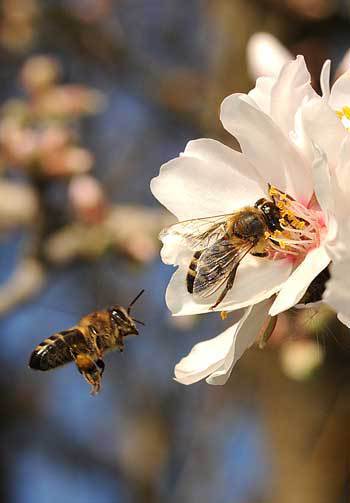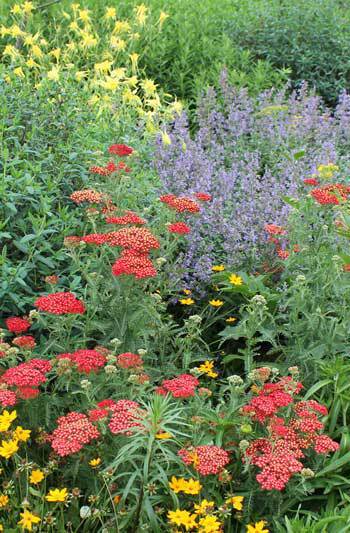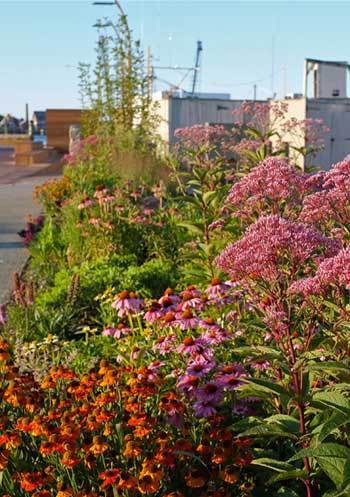"We need solutions to the bee crisis," said Laurie Davies Adams, head of the Pollinator Partnership, at a packed briefing on Capitol Hill, which was organized by her organization and the American Society of Landscape Architects (ASLA). The honey bee crisis Adams is deeply worried about is caused by the spread of colony collapse disorder, which has decimated hives across the U.S. Scientists say a combination of stressors is killing off honey bees, including the loss of the habitat they need for foraging, the widespread use of agricultural pesticides and fungicides, and disease. Other critical pollinators, like native bees, monarch butterflies, and bats, face similar challenges. While the destruction of these species is a cause of concern in itself, it's also causing real fears among many of country's farmers who rely on honey bees to pollinate their crops, at a cost of billions every year.
President and First Lady Obama have a "personal interest" in fixing the problem, said Adams. President Obama launched an inter-departmental task force that led to a new national strategy for honeybees and other pollinators, which was just released a few weeks ago. Adams called this the "most comprehensive blueprint for conservation in the 21st century." But she cautioned that the federal government alone can't solve this problem: it will take state and local governments, non-profit community groups, farmers, businesses, and homeowners, too. In fact, a key part of the effort will be to get people with any type of property to step up, which is the goal of the newly-launched Million Pollinator Garden Challenge. As Nancy Somerville, Hon. ASLA, CEO of ASLA, added, landscape architects and designers also play a key role in turning landscapes at all scales into healthy habitats. "Restoring habitat for pollinators can happen even in very small patches."
At the briefing, Anne Kinsinger, U.S. Geological Survey and one of the leaders in the presidential task force, said the group successfully brought together the many departments that can help -- defense, transportation, education, and the General Services Administration (GSA). This task force, together with Reps. Alcee Hastings and Jeff Denham, have pushed for the Highway BEE Act, which would transform 17 million acres around highway right-of-ways into habitat for pollinators. For example, Interstate 35, which runs from Mexico from Canada, could be planted with milkweed, providing a source of nutrients for Monarch butterflies all along their migratory route.
interstate
Rep. Denham, who spoke at the briefing, said it would be a way to "beautify the highways while also creating a transportation system that supports healthy pollinators." As of writing this post, the Highway BEE Act has passed the Senate Committee on Environment and Public Works. Next steps to make this law are getting the act through the full Senate and also moving it through the House of Representatives.
While the Highway BEE Act moves through the Hill, the national strategy has already made some important contributions. It pulled together 75 leading bee scientists to come up with a "research action plan." There are now targets: reduce colony collapse disorder by 50 percent in 10 years. Increase Monarchs' numbers from around 37 million today to 225 million in 5 years. Restore 7 million acres of pollinator habitat through public-private partnerships, to aid all kinds of pollinators. As Kinsinger explained, "you can't separate European honey bees from the 4,000 native bees." The GSA is also already revising its policies for 3,000 government facilities to include best-practice land management techniques.
Robert Sneickus, FASLA, national landscape architect with the USDA's National Resource Conservation Service (NRCS), which is charged with restoring vast public wildlife habitat, said pollinators are essential to 80 percent of flowering plants. In turn, the health of pollinators themselves are dependent on access to productive habitat. For Sneickus, what's important is planting "winter cover crops" that will be green all winter so bees will have access to forage in all seasons as well as flowering annuals that come back year after year. Also, all types of landscapes should be planted for both pollinators and beauty. "If a landscape looks great, more people will want it." He said landscape architects can create a "pollinator master plan" to restore even small patches and corridors as healthy, beautiful habitats.
And then John Chandler, a fourth-generation California farmer and agriculture advocate, explained how honey bees are crucial to his farm, which grows almonds, peaches, plums, and nectarines. As bees continue to die off, the cost per hive continues to go up, reaching about $200 these days. Each acre of almonds, explained Chandler, needs about two hives, so just for one growing season Chandler will spend $350 million to cover his entire 800,000-acre farm. "It's the single largest check to payout."
"What are we doing as an industry?", wondered Chandler. Beginning in the 70s, Blue Diamond almonds started to finance advanced bee research and then created some pamphlets for farmers. There were some common sense ideas: When bees are out pollinating during the day, farmers shouldn't be spraying chemical pesticides or fungicides. Farms now do that spraying at night when bees have gone home to their hives. During spraying, all water sources are also covered up so they aren't contaminated. Chandler said "bees are like us, they want clean, fresh water."
But, clearly, even more is needed to restore pollinators to health. According to the speakers, a key piece of the puzzle is bringing back nutritious forage wherever possible. Let's start with better integrating forage opportunities along highways. With today's problems, we can't afford single-use infrastructure anymore; a highway for both cars and pollinators makes more sense. And farmers could be given greater incentives to set aside parts of their farmland as forage, a strategy the UK government has been using for some time. Communities can turn their own thoroughfares into pollinator pathways. Just about any strip will work, given many pollinators have a multiple-mile foraging range, and, as Adams, explained, "if you plant it, they will find it."
Pollinator Pathway / Kim Smith Design
Lastly, everyone with a yard needs some plants for pollinators, too. Learn more at the Million Pollinator Garden Challenge.




